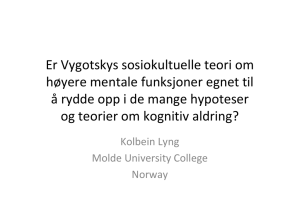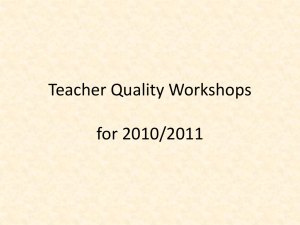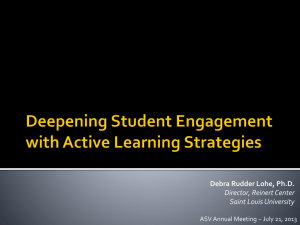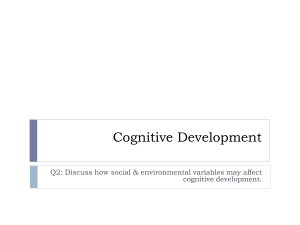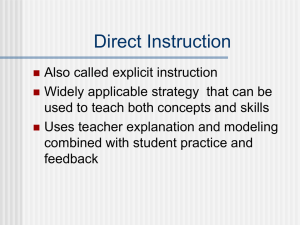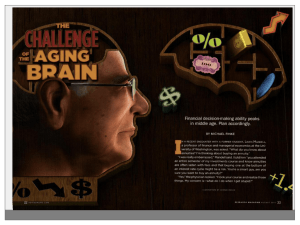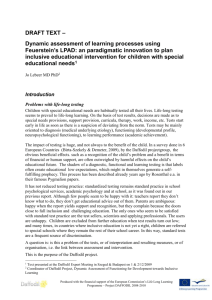Ruby Payne*s - MyCareerSwitch
advertisement
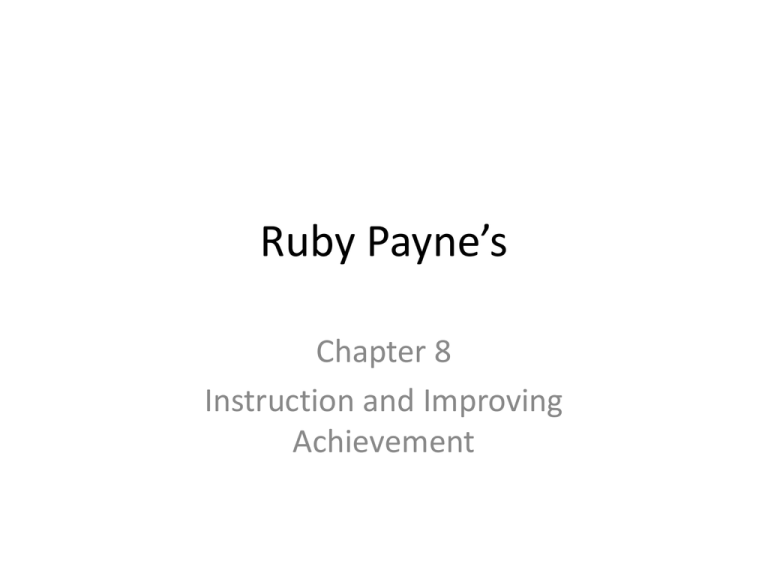
Ruby Payne’s Chapter 8 Instruction and Improving Achievement Book’s Purpose • “To improve achievement of students from poverty. Low achievement is closely correlated with lack of resources, and numerous studies have documented the correlation between low socioeconomic status and low achievement.” Notions of Intelligence • Traditionally thought that intelligence was inherited. • In the book, The Bell Curve it is noted that individuals in poverty have on the average an IQ nine points lower than individuals in the middle class. • This might be a credible argument if IQ tests really measure ability. In reality, IQ tests measure acquired information. An IQ Test • What is gray tape and what is it used for? • What does dissed mean? • What are the advantages and disadvantages of moving often? • What is the main kind of work that a bondsman does? • What is a roach? • How are a pawnshop and a convenience store alike? How are they different? IQ Tests • IQ tests were designed to predict success in school. They do not predict ability or basic intelligence. • Since IQ tests truly assess acquired knowledge, if your parents are educated, chances are you will have a higher acquired knowledge base. • Rather than using IQ tests, it is better to focus on teaching and learning. A Focus on Learning Structures • Teaching is what occurs outside the head. • Learning is what occurs inside the head. • In order to learn, an individual must have certain cognitive skills and must have a structure inside his/her head to accept the learning—a file cabinet or a piece of software. Cognitive Strategies • • • • Fundamental ways of processing information. The infrastructure of the mind. More basic than concepts. Subsets of Cognitive Strategies are Concepts, Skills, and Content. • Concepts store info and allow for retrieval. • Skills (reading, writing, computing, etc.) comprise the processing of content. • Content is the “what” of learning. Traditional Schooling • Traditionally, schools have believed that cognitive strategies are in place. If we didn’t find those strategies, we would test and place the student in a special program. Historically, we have believed that cognitive strategies were non-remediable. Historically, we have focused on concept development in K or K-1. We have focused on skills development in grades 2-5. We focused on content in 6-12. Didn’t Work!! • Increasingly, students, mostly from poverty, are coming to school without concepts, but more importantly they are coming to school without cognitive strategies. • We simply cannot assign all poor students to special education classes. Cognitive Strategies • Authored by Reuven Feuerstein, from Israel. • Studied under Jean Piaget. • Disagreed with Piaget in that Feuerstein believed that between the environmental stimulus and the response should be mediation. • For example, a parent might say, “Don’t cross the street.” (a stimulus). “You could get hit by a car.” (assigning meaning). “So, if you must cross the street, look both ways.” (identification of a strategy) Why Mediation is So Important If an individual depends upon a random, episodic story structure for memory patterns, lives in an unpredictable environment, and has not developed the ability to plan, then… Mediation • If an individual cannot plan, he/she cannot predict. • If an individual cannot predict, he/she cannot identify cause/effect. • If an individual cannot identify cause/effect, he/she cannot identify consequence. • If an individual cannot identify consequence, he/she cannot control impulsivity. • If an individual cannot control impulsivity, he/she has an inclination toward criminal behavior. Identifying Missing Links • Feuerstein identified the missing links that occur when mediation has not occurred. • Missing Links: – Mediated Focusing: Ability to focus attention and see objects in detail. – Mediated scheduling: Based on routine. Ability to schedule and plan ahead. Ability to represent the future abstractly and therefore set goals. – Mediation of positive anticipation: Ability to control the present for a happy representation of the future. Missing Links continued – Mediation of inhibition and control: Ability to defer gratification, think before acting, and control impulsiveness. – Mediated representation of the future: Ability to construe imaginatively a future scenario based on facts. – Mediation of verbal stimulation: Use of precise language for defining and categorizing the environment. – Mediated precision: Ability to precisely define situations, things, people, etc. and use that precise thinking for problem-solving. Cognitive Issues • Blurred, sweeping perceptions and the lack of a systematic method of exploration mean students have no consistent or predictable way to get information. • Impaired verbal tools mean they do not have the vocabulary to deal with cognitive tasks. • Impaired temporal orientation is the inability to organize and measure in time. • Impaired observations of constancies • Lack of precision and accuracy in data-gathering Cognitive Strategies of Support • Input Strategies that teachers must help build – – – – – – – – – – – – Use planning behaviors Focus perception on specific stimulus Control Impulsivity Explore data systematically Use appropriate and accurate labels Organize space with staple systems of reference Orient data in time Identify constancies across variations Gather precise and accurate data Consider two sources of info at once Organize data (parts of a whole) Visually transport data Cognitive Strategies of Support • Elaboration (use of data) Strategies that will support student growth – – – – – – – – – – – – Identify and define the problem Select relevant clues Compare data Select appropriate categories of time Summarize data Project relationships of data Use logical data Test hypotheses Build inferences Make a plan using data Use appropriate labels Use data systematically Cognitive Strategies of Support • Output (Communication of the data) Strategies – Communicate clearly the labels and process – Visually transport data correctly – Use precise and accurate language – Control impulsive behavior Teacher Lesson Planning • The student would – – – – – Use planning behaviors Control impulsivity Use evaluative behaviors Explore data systematically Use specific language Regardless of the content, if the lesson requires than in some way students do these five things, cognitive strategies would be strengthened. Use of Eye Movement • Bandler and Grinder (1979) work on non-verbal cues and cognitive processing • Criminologists use these techniques, also. • Think of the human face as a clock. • The face has three zones. • When the gaze is in the top zone, the individual is processing visual info. • When eyes in the middle zone, the person is processing auditory info (with one exception) • When eyes are in the bottom zone, the individual is either talking to himself or processing feelings. Use of Instructional Interventions • Graphic Organizers, p. 100, 101 • Identifying methods of having a systematic approach to the data/text. • Establishing goal-setting and self-talk. • Teaching conceptual frameworks as part of content. • Using a kinesthetic approach • Using rubrics • Teaching the structure of language. • Teaching students to make questions. • Sorting relevant from irrelevant cues. • Teaching mental models What the Research says • Insistence (schools have often excelled in insisting) • Expectations (been in place since the mid-1970s) • Supports in place (not fuzzy, feel-good notion of support. Instead, teachers need to offer supports like girders to a bridge). Support like cognitive strategies, appropriate relationships, coping strategies, goal-setting opportunities, and appropriate instruction. VDOE perspective on working with children from poverty • • • • Offer developmental pre-school programs Supplemental reading programs Reducing class size School-wide projects in prevention and support • These four responses could allow for relationships, support, insistence, and developmental and cognitive strategies. Conclusion • As we adapt and flex our instruction to meet the needs of students from poverty, cognitive strategies and support need to be integrated with insistence and expectations.

